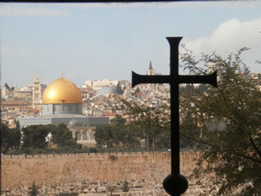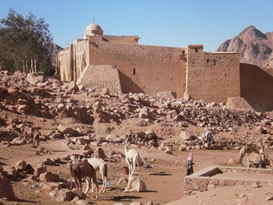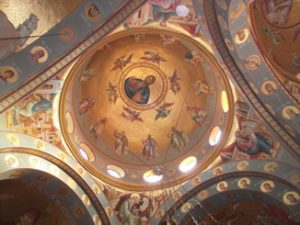We had been planning a month-long visit to France, when my sister wrote to me and said, “Let’s go to Israel instead, it’s been your dream for so long.” Indeed. I flew into Tel Aviv and while waiting for my sister to arrive, I heard joyous singing coming from the Greeter’s Area.
There was a large group of young Israeli men singing and dancing. Soon an older couple – presumably their rabbi and his wife – came through the gate, the young men encircled them, singing and dancing. Thus begun my month in Israel.
 We stayed at an Arab-run hostel in the old city of Jerusalem (fig. 1), which became the perfect ‘home’ for us. We were very near the Holy Sepulchre Church, which quickly became ‘our church’. Walking in the church for the first was an emotional experience for me, it brought tears to my eyes, the beauty, the history, its majesty and timelessness. We went often to the 6.30 Mass to begin our day. Each time we stopped in, we discovered something we’d not seen or learned before. The Church of the Holy Sepulchre is held sacred by Orthodox and Catholic Christians as the place of the crucifixion and burial of Jesus. In total, six different denominations, many of them ancient communities, celebrate their rites and services in this majestic house of worship. Ethiopian Christians go back to the time of St Philip and the Syriac Orthodox – to date – still use Aramaic, the language of Jesus. We attended many of these differing celebrations.
We stayed at an Arab-run hostel in the old city of Jerusalem (fig. 1), which became the perfect ‘home’ for us. We were very near the Holy Sepulchre Church, which quickly became ‘our church’. Walking in the church for the first was an emotional experience for me, it brought tears to my eyes, the beauty, the history, its majesty and timelessness. We went often to the 6.30 Mass to begin our day. Each time we stopped in, we discovered something we’d not seen or learned before. The Church of the Holy Sepulchre is held sacred by Orthodox and Catholic Christians as the place of the crucifixion and burial of Jesus. In total, six different denominations, many of them ancient communities, celebrate their rites and services in this majestic house of worship. Ethiopian Christians go back to the time of St Philip and the Syriac Orthodox – to date – still use Aramaic, the language of Jesus. We attended many of these differing celebrations.
Directly across from the place revered as Jesus’ Tomb was the Russian Orthodox Church which housed ‘the Center of the Universe’ signified by a marble chalice with a host. The walls were adorned with old icons of various sizes. I had never particularly cared for icons whilst my sister had a long-time love for them. She pointed out the beautiful Iconostasis above the altars and over the entryway to Jesus’ Tomb. In our stay in Israel, we saw many iconostases and icons in the churches we visited but the most exquisite were in St Catherine’s.
 The Greek Orthodox Monastery of St Catherine in the Sinai is located at the foot of Mt Horeb, purported in the Old Testament to be where Moses received the Ten Commandments or Tablets of Law. The three great religions, Judaism, Christianity and Islam, all hold this site sacred. The fortress-church tucked in the rugged mountainous landscape was founded in the 6th Century and is a splendid example of Byzantine architecture and one of the few still dedicated to ascetic monasticism. Sitting on the hillside, looking down at the monastery, with Bedouins and their camels hoping to take a tourist up the mountain, you could still be in the time of Jesus (fig. 2).
The Greek Orthodox Monastery of St Catherine in the Sinai is located at the foot of Mt Horeb, purported in the Old Testament to be where Moses received the Ten Commandments or Tablets of Law. The three great religions, Judaism, Christianity and Islam, all hold this site sacred. The fortress-church tucked in the rugged mountainous landscape was founded in the 6th Century and is a splendid example of Byzantine architecture and one of the few still dedicated to ascetic monasticism. Sitting on the hillside, looking down at the monastery, with Bedouins and their camels hoping to take a tourist up the mountain, you could still be in the time of Jesus (fig. 2).
 Interestingly, the church was originally dedicated to the Virgin Mary, but in the 3rd Century changed to honor St Catherine; relics of her head and hand are enshrined there. The small, main Church of the Transfiguration together with the museum hold the largest and oldest collection of icons in the world, some from the 6th Century (fig. 3). We were drawn to a set of three icons on a wall in the interior of the church, Jesus; the Pantocrater or Teacher with his mother Mary holding the infant Jesus on his left and St Peter to his right. Each time we entered, we went to these images, indeed we were drawn there.
Interestingly, the church was originally dedicated to the Virgin Mary, but in the 3rd Century changed to honor St Catherine; relics of her head and hand are enshrined there. The small, main Church of the Transfiguration together with the museum hold the largest and oldest collection of icons in the world, some from the 6th Century (fig. 3). We were drawn to a set of three icons on a wall in the interior of the church, Jesus; the Pantocrater or Teacher with his mother Mary holding the infant Jesus on his left and St Peter to his right. Each time we entered, we went to these images, indeed we were drawn there.
A month before coming to Israel, our young parochial vicar gave a brief talk to the 7th and 8th graders and anyone who cared to join. He told us icons are written, not drawn and each line has meaning. He had several he had created on display and gave each of us Holy Cards of the images. I found it so interesting and informative and I think, this introduction opened my eyes to ones we would be seeing.
The first time I heard of St Catherine in the Sinai was nearly twenty years ago. The local priest at that time, Father Gary, himself an icon painter and artist, spoke of the icons at St Catherine’s and the beauty of the mountains, sky and desert. I knew it was a place I needed to see.
My sister and I loved being there. Every morning we woke up at the crack of dawn – it was extremely cold until the sun came up – and walked to the early service. On our first visit, we had the good fortune to meet Father Gregory, one of the monks, who answered our many questions and through his good graces, we were able to attend their private service. Because we were not Greek Orthodox, we were not able to receive Holy Communion, but nonetheless we felt a part of their service. After we would wander through the old hauntingly beautiful church and appreciate the many icons, always ending at the powerful Pantocrater. On one occasion we had the very special honor of joining the monks for tea and cakes. One of the younger monks spoke some English and told us about monastic life there.
The night sky in Sinai was awesome – stars were so bright and we appreciated the full moon our last night there. It felt a kind of blessing. We felt a sadness leaving the desert and this monastery which has enchanted visitors for centuries. But there was so much more to experience.
Coming to Israel was a dream come true. I have always wished to walk in the footsteps of Jesus, my own pilgrimage. Continuing our journey, we took busses to the marvelous Roman ruins of Beit She’an and on to Nazareth, the Palestinian city dedicated to the Virgin Mary. From there we went to the Sea of Galilee and stayed in a hostel in Tiberius, a town with mostly Jewish residents. On the Sabbath, Friday evening sunset until Saturday sunset, no transport is allowed so we found ourselves hitchhiking – another first for me – to Capernaum and other Christian sites in Galilee.
 Many people we spoke to felt deeply about the Beatitudes Shrine, but we felt peace and gratitude in Tabgha, the chapel of the first feeding of the multitudes with loaves and fishes. The bird and animal mosaics on the floor were ancient and so beautiful (fig. 4). We walked further to the Church of St Peter’s Primacy, a very small chapel with no pews but with the same feeling of peace and restfulness. We walked out the gate to the shore of
Many people we spoke to felt deeply about the Beatitudes Shrine, but we felt peace and gratitude in Tabgha, the chapel of the first feeding of the multitudes with loaves and fishes. The bird and animal mosaics on the floor were ancient and so beautiful (fig. 4). We walked further to the Church of St Peter’s Primacy, a very small chapel with no pews but with the same feeling of peace and restfulness. We walked out the gate to the shore of
the Sea of Galilee and were filled with a sense of Jesus’s presence.
The icons and paintings in the red-domed Greek Orthodox Church of the Twelve Apostles in Capernaum were also impressive. The location equally remarkable and imposing on the shore of the Sea of Galilee. The Pantocrater in the central dome of the church was striking, this powerful image became very familar to us. (fig. 5)
We were fortunate to find a single ride back to Tiberius. We wandered through the small town and ended up at the ancient, splendid church dedicated to St Peter for the 18.30 Mass in Hebrew. The young priest was a warm, charismatic man and very interesting to listen to – a tiny church of peace and joyousness, inviting us to join in the sense of community.
From Tiberius we took busses to Safid, a Jewish enclave of Cabbalists high up in the hills and then on to Acre (Akko), a marvelous old walled town on the Mediterranean Sea. History is written in the stones of this ancient town, from the Crusades to the domination of the Muslim conqueror Saladin. Many early pilgrims started their pilgrimage to the Holy Land from Acre, protected on their journey by the Knights of St John.
The ancient Caesarea Maritima is a fascinating old Roman city and harbor on the Mediterranean Sea built in 25–13 BCE by Herod the Great, whose presence was in evidence throughout Israel. Both the apostles Peter and Paul came to Caesarea; Paul was imprisoned there for two years before being sent to Rome. We took an entire day to walk the ruins. The aquaducts which snaked along the shore were marvelous and it was one of the few ruins that allowed you to see the majesty of Roman Hippodromes.
On a stormy day, we headed back to Jerusalem. I had hoped to be able to walk the Snake Path, originally used by the zealots, up to Masada and with determination managed going up and coming back down. It was a lovely, clear day and we could smell the salty air from the nearby Dead Sea, visible in the distance. It was Herod who also built the fortress atop Masada but it was the mass suicide of the Jewish rebels, choosing to die rather than be captured by the Romans, who made it a symbol for the state of Israel. Indeed, the site was crowded with school groups, soldiers and Israeli families.
On Christmas Day eve, we took Palestinian busses to Bethlehem. There were many festivities, Christian and secular, and the city was packed with people from all over the world, eager to celebrate this special night in the town of Jesus’ birth. That evening before returning to Jerusalem, we met a teacher who helped us find our way to the wall built by the authorities to prevent rockets from hitting the homes of the nearby Jewish settlers. The woman pointed out the hillsides where Palestinian families had been tending olive trees and vineyards for generations. Tanks and earth-moving equipment had razed the ground for the Jewish settlements that dot the hillsides now. We were told the original occupants still hold the keys to their now, non-existent homes. In our travels across the country we saw that Palestinians always need to carry their identity cards and show them at the many check points and on busses, travel is restricted by the type of card they hold. They are classified as residents but do not have Israeli Citizenship. I wonder if there will ever be a solution for all these people to live together in peace.
On a cold rainy day we took the tram to Yad Vashem, a haunting place. The weather was appropriate for the profound sadness that overwhelmed us. The beauty of Marc Chagall’s incredible stained glass windows in the Synagogue of the Hadassah Hospital, was a sharp contrast to the somberness of the Holocaust Museum. Twelve windows of enchanting colors and shapes depicting the Twelve Tribes of Israel from the Old Testament. Perhaps these two visits were a fitting finale to end our time in Israel.
We were so blessed in our month in the Holy Land.
By Mary Jean Durant
